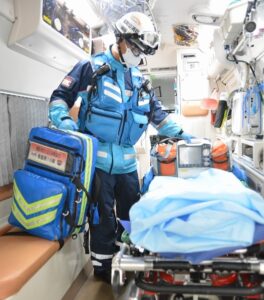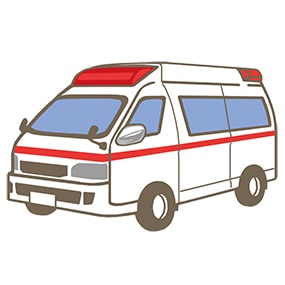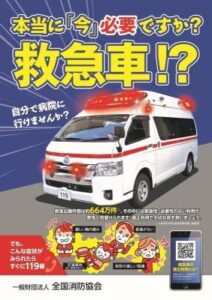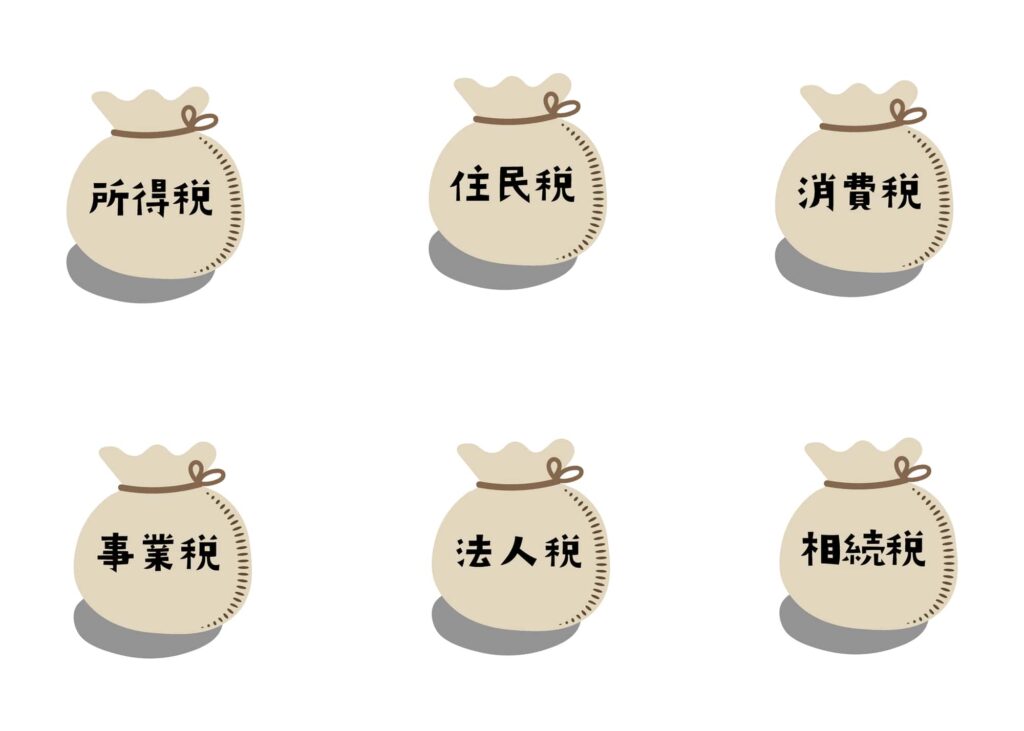
The use of ambulances in Japan has been the subject of much debate in recent years.
The reason behind this is the increase in the number of ambulance dispatches and the resulting delays in arrival times.
To address this issue, Matsusaka City in Mie Prefecture has introduced a new system starting in June 2024.
Under this system, if a patient is transported by ambulance but does not end up being hospitalized, a fee of 7,700 yen will be charged.
The decision has sparked mixed reactions from many citizens and experts.
This article provides a detailed explanation of this system, its background, impact, and future prospects.
目次
- 1 Overview of ambulance fees
- 2 Impact of charging for ambulances
- 3 Pros and cons of charging for ambulances
- 4 Potential problems that could arise from charging for ambulances
- 5 Precautions and things to know when using an ambulance
- 6 Future outlook for ambulance fees
- 7 Summary: The significance of charging for ambulances and what we can do
Overview of ambulance fees
Overview of ambulance fees
Starting in June 2024, Matsusaka City in Mie Prefecture will introduce a system that charges 7,700 yen for patients who are transported by ambulance but do not end up being hospitalized.
This system applies to the city’s core hospitals (Matsusaka Municipal Hospital, Saiseikai Matsusaka General Hospital, and Matsusaka Central Hospital).
The aim of the new fee system is to improve the efficiency of emergency medical services and reduce financial burdens.
The background to this system is the ever-increasing number of ambulance calls, resulting in delayed arrival times.
In 2022, arrival times will reach 9 minutes 43 seconds, which represents a delay of about 2 minutes compared to 2013.
Given these circumstances, there is a strong demand for proper use of ambulances.
Why 7,700 yen? The basis and calculation method
This fee is incurred when the hospital determines that the condition is not an emergency or serious, and is charged as “selected medical expenses” that are not covered by insurance.
The 7,700 yen fee was set to curb excessive use of emergency medical care.
This amount has been calculated as an appropriate amount for medical institutions to bear, taking into account the costs of dispatching an ambulance and labor costs.
Specifically, there are cases where exemptions are available in the case of traffic accidents or work-related accidents, and the hospital will make a judgment on each case and make a claim.
For this reason, it is not imposed on all patients, but is determined on a case-by-case basis.
The system aims to fairly share the burden of emergency medical care and discourage non-emergency use.
The current status of ambulance use in Japan
In Japan, the number of ambulance calls is increasing every year, especially for non-urgent cases, which is putting a heavy strain on emergency medical services.
In 2022, approximately 7 million ambulance dispatches were recorded nationwide, with around 60% of these being for minor injuries.
This situation causes delays in the arrival time of ambulances, making it difficult to provide prompt response to patients with urgent needs.
According to 2022 data, the average ambulance arrival time is 9 minutes and 43 seconds, which represents a delay of about two minutes compared to 7 minutes and 54 seconds in 2013.
Optimizing ambulance use and future issues
In order to promote the proper use of ambulances, it is important to educate users.
If it is difficult to determine the urgency of the issue, it is recommended that you use a consultation hotline such as “#7119.”
Doctors and nurses will respond to this number and provide appropriate advice, helping users to visit appropriate medical institutions.
Future challenges include establishing a subsidy system to reduce the financial burden and strengthening education and awareness-raising activities to ensure appropriate use of ambulances.
It is also important to strengthen cooperation with local governments and implement measures that are tailored to the characteristics of each region.
This will improve the quality of emergency medical services and aim to build a sustainable medical system.

Impact of charging for ambulances
Charging for ambulances could change attitudes towards using emergency medical services.
The reason for the introduction of this system in Japan is the increase in the number of ambulance calls and the resulting strain on medical resources.
It is expected that charging fees will promote appropriate use and improve the quality of medical services.
But this comes with a number of implications.
Economic burden on patients and measures to address it
Charging for ambulances would place a direct financial burden on patients.
This cost burden can be particularly problematic for financially disadvantaged patients and the elderly.
Under the system in Matsusaka City, Mie Prefecture, if the patient does not end up being hospitalized, 7,700 yen will be charged.
The purpose of this is to curb non-urgent use, but it is also possible that people may hesitate to use it when necessary.
Possible solutions to this problem include:
- Introduction of a subsidy system : We will reduce the burden on patients in financially difficult situations by introducing subsidies and exemptions.
- Awareness-raising activities : In order to promote appropriate use, we will strengthen the provision of information on emergency response procedures and standards for using ambulances.
- Strengthening consultation hotlines : We will expand telephone consultation hotlines nationwide, such as “#7119,” which help users determine the urgency of an emergency, to support users in making appropriate decisions.
Impact on emergency medical services
The introduction of fees for ambulances is expected to have a major impact on emergency medical services as a whole.
First, it is expected that charging for medical services will reduce non-urgent use, thereby decreasing the number of ambulance dispatches and, as a result, enabling quicker response to patients with truly urgent needs.
It will also reduce the burden on medical institutions and create an environment in which emergency medical staff can work more efficiently.
On the other hand, there is a risk that reduced usage will lead to reduced emergency medical care systems in some areas.
This raises concerns that access to medical care will worsen, especially in rural and depopulated areas.
Comparison with other countries
Other countries have also implemented paid ambulance services, and a great deal of knowledge has been accumulated about their effectiveness and challenges.
For example, in the United States, there is a fee for using an ambulance, and users typically pay for this through insurance.
This system has reduced wasteful utilization and made efficient use of medical resources.
Meanwhile, in France, ambulance service is provided free of charge, but this has resulted in an increase in the number of ambulance calls and delayed response times.
In response to this, Germany has introduced a partial self-payment system for ambulance use, which has been shown to be effective in discouraging non-urgent use.
These examples show that in order to verify the effectiveness of fee-for-service in Japan, it is important to continuously monitor utilization after the introduction of the system and its impact on medical services.
In addition, flexible responses that take into account the characteristics of each region are required.
For example, access to medical care differs between urban and rural areas, so it is necessary to take measures that are appropriate for each.
summary
Charging for ambulances is an effort to promote appropriate use and make more efficient use of medical resources.
However, there are still issues regarding the financial burden and fairness of access to medical care. In order to overcome these issues, it is essential to improve subsidy systems and awareness-raising activities.
Furthermore, it is important to take flexible measures suited to the characteristics of each region, while referring to examples from other countries.

Pros and cons of charging for ambulances
While the introduction of ambulance fees aims to improve the efficiency of emergency medical services and reduce the financial burden, there are many pros and cons to the move.
In Japan, Matsusaka City in Mie Prefecture is scheduled to start charging for ambulance rides from June 2024, with a fee of 7,700 yen being charged if the injury does not result in hospitalization.
Opinions on this new system are largely divided between those in favor and those against it, and various alternatives have also been proposed from neutral viewpoints.
Arguments for proponents: Fairness in cost sharing and fiscal soundness
Those in favor of charging for ambulances argue that it would ensure fairness in the burden of costs and contribute to fiscal soundness.
Specifically, this includes:
- Optimizing use : By improving the current situation where free use of ambulances leads to excessive dispatches and limiting their use in less urgent cases, it will be possible to provide quicker response to patients who truly need it.
- Reduction of financial burden : Operating ambulances incurs a huge cost, and charging a fee will reduce the financial burden on local governments by passing part of that cost on to users. This will allow limited medical resources to be used more efficiently.
- Ensuring fairness : Free ambulance service leads to excessive use by some users, so charging for ambulances will ensure fair cost sharing. This will improve the fairness of medical services.
Opponents’ arguments: Restrictions on access to emergency medical care and issues of fairness
Opponents worry that fees would restrict access to emergency care and raise equity questions.
The main objections are:
- Increased financial burden : Patients in financially disadvantaged situations may be reluctant to use an ambulance due to the fee. This cost burden can be a significant barrier, especially for low-income earners and the elderly.
- Inequality in access to medical care : Depending on the region, there may be disparities in access to emergency medical services. There is a concern that charging for medical services will widen the gap between urban and rural areas in terms of the availability of medical resources.
- Difficulty in determining the urgency of an emergency : It is often difficult for ordinary citizens to determine the urgency of an emergency, and charging an ambulance increases the risk that people will inappropriately choose not to use an ambulance. This could lead to delays in appropriate response in situations where emergency medical care is needed.
Neutral viewpoints and alternatives
From a neutral perspective, the pros and cons of charging are balanced and the following alternatives are proposed:
- Partial fee-charging : Instead of imposing a uniform fee on all users, it is possible to charge fees according to income or only for non-urgent uses. This will reduce the burden on patients who are in financial difficulty.
- Raising awareness of proper use of ambulances : It is important to raise awareness of proper use of ambulances through education and awareness-raising activities for citizens. For example, it has been proposed to expand telephone consultation services such as “#7119” nationwide and establish a system to support judgment of urgency.
- Introduction of subsidy system : In order to reduce the economic burden, the introduction of subsidies and exemptions is being considered. Financial support to reduce usage fees is especially necessary for low-income earners and the elderly.
summary
The introduction of a fee for ambulances is an important initiative that aims to promote appropriate use and make efficient use of medical resources.
However, there are still issues regarding the financial burden and fairness of access to medical care. In order to overcome these issues, it is essential to improve subsidy systems and awareness-raising activities.
It is also important to take flexible measures suited to the characteristics of each region, while learning from examples in other countries.

Potential problems that could arise from charging for ambulances
Charging for ambulances is an effort to promote the appropriate use of emergency medical services and make more efficient use of medical resources, but it has the potential to cause a variety of problems.
These issues need to be considered from the perspective of the risk of reduced utilization in emergency situations, widening disparities and regional differences in medical care, and an increase in fraudulent utilization due to the introduction of paid services.
Risks of refraining from use in emergency situations
If ambulances become a paid service, there is a risk that people will refrain from using ambulances for financial reasons.
In particular, low-income earners and those in economically disadvantaged situations may be hesitant to use an ambulance even in an emergency.
This situation will result in people losing the opportunity to receive appropriate medical care and increase the risk of worsening health damage.
For example, not using an ambulance in a timely manner for urgent symptoms such as a heart attack or stroke could lead to the patient’s condition worsening, and in the worst case scenario, death.
In order to reduce this risk, it is necessary to clarify the criteria for using ambulances and take measures such as exempting fees in cases of high urgency.
It is also important to raise public awareness of how to use ambulances appropriately through public awareness activities.
Widening medical disparities and regional differences
Charging for ambulances could widen the gap in medical care.
There are large disparities between urban and rural areas in terms of the availability and access to medical resources, and there are concerns that introducing fees will widen this gap even further.
Fees could put rural residents at a disadvantage, as medical facilities are often far away and the use of an ambulance is often essential.
In addition, since each local government has its own system of financial support and whether or not they provide subsidies for ambulance use, there may be differences in how the situation is handled from area to area.
For this reason, it is necessary to establish uniform nationwide standards and work with local governments to implement support measures tailored to regional characteristics.
This calls for ensuring fairness in access to healthcare.
Increase in fraudulent use due to fee-based services
As ambulances become a paid service, there is also a risk that fraudulent use will increase in order to avoid paying the fees.
For example, there may be cases where people try to avoid using an ambulance by making false declarations or using fraudulent means.
This could undermine the credibility of the entire emergency medical system.
In order to prevent fraudulent use, it is necessary to strictly monitor ambulance usage and take strict action against false declarations.
Additionally, it is important to clarify the rules and standards regarding the use of ambulances and take steps to increase transparency in order to prevent fraud.
Furthermore, it is also effective to raise public awareness of the correct use of the system through education and awareness-raising activities.
summary
While charging for ambulances aims to make more efficient use of medical resources and improve financial soundness, it could also lead to problems such as the risk of people refraining from using ambulances in emergency situations, widening medical disparities, and increasing fraudulent use.
In order to address these issues, it is essential to clarify standards for ambulance use, provide more financial support, strengthen monitoring systems, and raise public awareness.
By taking appropriate measures, it is necessary to improve the quality of emergency medical services and build a sustainable medical system.

Precautions and things to know when using an ambulance
Using an ambulance is one of the important means of emergency care, but it is important to know how to use it properly.
In particular, in order to make the right decisions in emergency situations, it is important to know when to call an ambulance, how to compare it with other means of transportation, and how to respond in an emergency.
This chapter will explore these points in more detail.
When should you call an ambulance?
An ambulance should be called when the situation is urgent and requires immediate medical intervention.
These symptoms and situations include:
- Severe bleeding : Bleeding that is difficult to stop or is excessive.
- Impaired consciousness : Sudden loss of consciousness or failure to respond to calls.
- Shortness of breath : sudden shortness of breath or difficulty breathing.
- Chest pain : If you experience sudden chest pain or pressure and suspect a heart attack.
- Poisoning or overdose : Poisoning due to taking a drug or toxic substance.
- Severe injuries : Fractures, major bruises, and serious injuries from accidents.
In these situations, it is essential to call an ambulance and seek professional medical attention quickly.
If you are unsure what to do, we recommend that you contact an emergency hotline such as “#7119” and receive appropriate advice.
Comparison with using a private car or taxi
If the need is not urgent or the hospital is close by, you should also consider using your own car or a taxi.
Here is a comparison of each mode of transport:
- Ambulance : Ideal for emergency situations where rapid medical intervention is required. Medical staff are on board and initial treatment can be provided on-site.
- Private car : Suitable for cases where the emergency is not serious or the hospital is nearby and you can travel quickly. A family member or friend can drive you directly to the hospital.
- Taxis : Useful when you cannot use your own car or have difficulty driving. Suitable for less urgent situations, but medical support cannot always be expected.
By using these options appropriately, you can prevent the waste of emergency medical resources and receive prompt medical care when needed.
What users need to know in case of an emergency
In an emergency, it is important to take appropriate action before an ambulance arrives.
Here are some basic things you should know in case of an emergency:
- Cardiopulmonary resuscitation (CPR) : In the event of cardiac arrest or breathing arrest, performing CPR can increase the chances of saving a life. This involves chest compressions and artificial respiration, but it is recommended that you take a course to learn the correct procedure.
- Stopping bleeding : If bleeding occurs, apply pressure with a clean cloth or gauze to stop the bleeding. Keeping the bleeding area higher than the heart is also effective.
- Rest and keep warm : Even if the person is conscious, it is important to keep them still and at rest without moving them, and to keep them warm with a blanket or other covering.
- Foreign body removal : If a foreign object is stuck in the throat, it is necessary to remove it using the Heimlich maneuver or similar.
Knowing these methods will enable you to take appropriate measures and stabilize the patient’s condition until the ambulance arrives.
summary
Proper use of ambulances is one of the important measures in an emergency.
It is important to correctly assess the urgency of the situation and choose the appropriate means of transportation.
Also, knowing how to respond in an emergency will enable you to take appropriate action until an ambulance arrives.
If every citizen has this knowledge, it will improve the quality of emergency medical services and save lives.

Future outlook for ambulance fees
Charging for ambulances is an initiative aimed at promoting the proper use of emergency medical services and making more efficient use of medical resources, but there is also a lot of attention being paid to the impact of its implementation and its future prospects.
We will take a closer look at government and local government trends, service improvements and user feedback since fees were introduced, and the direction of future medical system reform.
Trends and future policies of the government and local governments
When it comes to introducing fees for ambulances, the government and local governments have put forward various policies.
This system implemented by Matsusaka City in Mie Prefecture has attracted attention nationwide, and there are signs that other local governments are considering similar initiatives.
The Government is taking measures to improve the sustainability of emergency medical services, including:
- Standardization of the system : We will create uniform guidelines for ambulance fees that can be used as a reference by local governments across the country, thereby ensuring the fairness and transparency of the system.
- Expanding financial support : Policies are being implemented to ease the financial burden on low-income earners and the elderly by offering reductions and subsidies for ambulance fees.
- Public relations activities : We will strengthen awareness-raising activities regarding the proper use of ambulances and inform citizens of the correct way to respond in an emergency.
Service improvements after the introduction of paid services and user feedback
Since the introduction of a fee for ambulances, improvements to the service have been made based on actual usage and feedback from users.
Below are some specific improvements and user feedback:
- Improving emergency consultation services : With the introduction of a paid service, it is recommended that people use emergency consultation services such as “#7119”. Doctors and nurses will respond to these services and provide advice on whether or not the call is urgent. This is expected to reduce the use of ambulances in non-emergency cases.
- Improving service quality : Based on feedback from users, efforts are being made to improve the quality of ambulance service, such as by increasing the number of medical equipment in ambulances and strengthening staff training.
- User feedback : Reactions to the fee system have been mixed. While some have praised it for being used appropriately in emergencies, many have expressed concerns about the cost burden. In response, local governments are working to provide more information and strengthen support systems.
Future direction of healthcare system reform
Charging for ambulances is positioned as part of future reforms to the medical system.
In the future, reforms are expected to be implemented to increase the sustainability of the entire healthcare system.
The main directions are as follows:
- Establishing sustainable healthcare finances : In order to improve healthcare finances, policies are being considered to promote efficient resource allocation and appropriate use. This includes not only charging for ambulances, but also reviewing healthcare costs overall.
- Utilizing technology : Smart medical care using AI and IoT is being introduced, which will enable a system to quickly determine the urgency of a patient’s condition and provide appropriate medical services.
- Strengthening regional medical cooperation : In order to correct the medical disparity between urban and rural areas, it is necessary to strengthen regional medical cooperation. Efforts are being made to enable people in rural areas to receive high-quality medical services by establishing remote medical care and regional medical networks.
summary
Charging for ambulances is an important step towards making more efficient use of medical resources and realizing a sustainable medical system.
By gaining a deeper understanding of government and local government trends, improvements to services after fees are introduced, and the direction of future healthcare system reform, we can create a society in which each of us can enjoy appropriate healthcare services.
It is expected that the provision of appropriate information and the improvement of support measures will contribute to improving the quality of emergency medical services.

Summary: The significance of charging for ambulances and what we can do
Charging for ambulances is an important initiative that aims to promote efficient use of emergency medical services and ensure the proper allocation of medical resources.
However, for this system to function properly, the understanding and cooperation of each and every citizen is essential.
Here, we will consider the significance of charging for ambulances and the concrete action plans we can take in response to this.
Understanding and cooperation regarding the introduction of paid ambulance services
The significance of charging for ambulances begins with understanding the issues behind it.
In Japan, the number of ambulance calls is increasing year by year, with non-urgent calls accounting for approximately 60% of the total.
This current situation is resulting in an excessive consumption of emergency medical resources and delays in responding to patients with high urgency.
Fees were introduced as a way to solve this problem.
It is important that each citizen understands the purpose of this system and makes an effort to use it appropriately.
Specifically, you will be required to correctly judge the urgency of the situation and, if necessary, consider using your own car or a taxi.
It is also important to learn how to respond in an emergency and be prepared to deal with it appropriately.
The future of emergency medical care that society as a whole should think about
There are many issues that society as a whole must address in order to improve the quality of emergency medical services and build a sustainable medical system.
First, it is necessary to clarify the standards for using ambulances and strengthen awareness-raising activities to promote appropriate use.
For example, it is important to encourage the use of the emergency consultation hotline “#7119” and establish a system to support citizens in determining the urgency of a situation.
Additionally, the government and local governments should provide support to people in financially difficult situations and take measures to reduce the burden of charging fees.
This includes providing tax exemptions and subsidies to low-income earners and the elderly.
Furthermore, it is necessary to ensure fair access to medical care by introducing smart medical care that utilizes technology and strengthening regional medical cooperation.
Specific action plans and the role of citizens
Some concrete action plans that we, as citizens, can take include the following:
- Education and awareness : To spread knowledge on the proper use of ambulances, it is recommended to participate in local workshops and seminars. It is also important to receive training on cardiopulmonary resuscitation (CPR) and first aid so that you can respond appropriately in an emergency.
- Information sharing : We will share information on the proper use of ambulances through social media and local bulletin boards, etc., to raise awareness throughout the community. It is especially important to convey information through familiar communication to the elderly and people who have difficulty accessing information.
- Support activities : You can participate in local volunteer activities to raise awareness and support emergency medical care. For example, you can participate in programs that teach emergency response methods and cooperate with local disaster prevention drills.
summary
Charging for ambulances is an important measure aimed at ensuring efficient use of emergency medical services and proper allocation of medical resources.
The success of this system depends on the understanding and cooperation of each and every citizen.
By striving to make proper use of ambulances, learning how to respond in emergencies, and sharing information throughout the community, we can improve the quality of emergency medical services and build a sustainable medical system.





